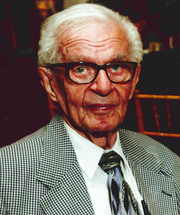 Equipped with little more than a microscope in the 1950s, Dr. Franz C. von Lichtenberg began studying infectious diseases in Mexico City, where his family lived after fleeing from Europe during World War II.
Equipped with little more than a microscope in the 1950s, Dr. Franz C. von Lichtenberg began studying infectious diseases in Mexico City, where his family lived after fleeing from Europe during World War II.
His expertise about a skin-penetrating parasitic worm that plagues polluted waters of Third World countries brought him acclaim and a job in Boston in 1958 at what was then the Peter Bent Brigham Hospital.
Bicycling to work from his Brookline home in all seasons, he shared his encyclopedic knowledge of tropical medicine with Harvard Medical School students for decades.
"He was a pillar of strength and a vibrant role model in our department of pathology," said Dr. Frederick J. Schoen, who is vice chairman of pathology at Brigham and Women's Hospital and a professor at Harvard Medical School. "He was just a remarkable man. We all learned not only by what he said, but by his example. He stood for all the right things."
Dr. von Lichtenberg, a researcher clinician and teacher at Brigham and Women's and Harvard Medical School for more than 50 years, died of a massive aneurysm Sept. 16 in Beth Israel Deaconess Medical Center. He was 92 and had retired in January. He gave up commuting by bike at age 88.
He witnessed his profession explode with technological advances. AIDS, the once mysterious disease he tried to unravel during a confounding autopsy in the early 1980s, can now be conceivably diagnosed from Mount Kilimanjaro with the help of a microchip and a cellphone, colleagues said.
Born in Miskolc, Hungary, Dr. von Lichtenberg grew up in Budapest, Berlin and Vienna. His father, Alexander, was a doctor and a pioneer in urology. His mother was the former Elizabeth Schneider.
When Dr. von Lichtenberg was a young medical student, his family immigrated to Mexico City in 1939 to escape the Nazi regime. He finished his studies at the Universidad Nacional Autonoma de Mexico in Mexico City and was a pathology fellow at Mount Sinai Hospital in New York City in 1950 and at what was then Columbia-Presbyterian Medical Center in 1951. He later worked at hospitals in Brazil and Mexico City, and at San Juan City Hospital in Puerto Rico.
His research caught the eye of Dr. Gustave Dammin, then chief of pathology at Peter Bent Brigham Hospital. Dr. von Lichtenberg accepted the hospital's job offer and in 1962 began teaching at Harvard Medical School. He was professor emeritus when he died.
"My father loved going on rounds with the students," said one of his sons, Alexander of Sudbury. "He was still lecturing, writing and teaching. That's one of the things that kept him going."
Soft-spoken and bookish, Dr. von Lichtenberg often surprised lecturers in recent years with his questions. "Literally up until the weeks before he died he was sitting in that front row and asking the questions we all wish we could have thought to ask," Schoen said.
Dr. Dan Milner was 26 when Dr. von Lichtenberg first became his mentor a dozen years ago. He said Dr. von Lichtenberg could be funny and warm while patiently sharing his wisdom with the next generation of pathologists.
"His eyes would light up, and he would chuckle and laugh," Milner said. "He was very much about getting the right answer and doing the right thing for the patient."
Dr. Robert Sackstein, a former student, recalled that one day he and Dr. von Lichtenberg stood shoulder to shoulder performing an autopsy on someone they would later understand had died of AIDS. Dr. von Lichtenberg marveled at the myriad complications posed by an unknown disease attacking the immune system.
"Back then, we didn't quite know what we were seeing," Sackstein said. "His ability to synthesize from experience was outstanding. I've just been blessed to have him as a teacher and a colleague."
Dr. von Lichtenberg was an expert on schistosomiasis, a chronic disease caused by a freshwater parasite. Sometimes called snail fever, it has infected more than 200 million people worldwide and is second only to malaria in causing devastation, according to the Centers for Disease Control and Prevention.
Traveling extensively in Africa, Asia and Latin America, Dr. von Lichtenberg was a consultant to the World Health Organization and was fluent in Spanish, German, Hungarian and conversational Japanese and French. He edited the 1991 edition of Pathology of Infectious Diseases, a key reference text for his profession, and was a regular contributor to medical journals.
Dr. von Lichtenberg met his future wife, Sandra Miriam Nathanson, in Mexico City. She was from Brooklyn, N.Y., and was vacationing in Mexico when family members introduced them.
"As my father liked to say, a two-week whirlwind romance turned into a marriage of 59 years," said Alex, who is general manager of Spanish language television stations WUNI and WUTF.
The von Lichtenbergs raised six children in an old Victorian home in Brookline. Mrs. von Lichtenberg died in 2007 at 79.
In addition to his son, Dr. von Lichtenberg leaves three daughters, Adriane of Brookline, Paula Reeves O'Brien of Randolph, and Karen Fernandez of Newton; two other sons, Stephen of Brookline and Charles of Boston; a granddaughter and a grandson.
A memorial service was held Oct. 13 in Brookline, followed by private burial in Vermont.
--Source: Boston Globe